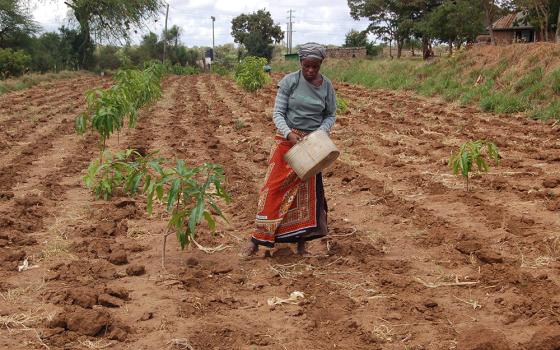I work at a monastery and I love food, so I was delighted to hear of a book published in 2009 called A Taste of Heaven: A Guide to Food and Drink Made by Monks and Nuns. The author, Madeline Scherb, hails from the west side of Madison, Wis., and is a graduate of my high school alma mater's rival. It only made sense to chat with her and get the scoop on how this book came together and where she's going next.
Madeline is a relatively recent convert to Roman Catholicism. She read an article about nuns making fruitcakes, and she started to wonder whether other monks and nuns were making food. Sure enough, they were, so she began pitching her book idea to agents and publishers. She started traveling Europe in 2007, visiting monasteries throughout western Europe and sampling the delicacies brought by men and women who had taken vows for religious life.
Madeline noted there are two kinds of food served at the monasteries she visited: food served to guests and food sold to sustain the works of the monastery. The former is an age-old tradition, where pilgrims on a journey during the Middle Ages would stop at a monastery for a place to sleep and a bite to eat. Madeline traveled similarly through Europe, sometimes having a monk wheel in beer on a cart in the dining area. She noted that most times, the nuns and monks she encountered wouldn't consume the beverages they were trying to sell, attempting to live a very "ascetic" life, as she put it.
Most of the food she tasted on her travels was superb. However, when she visited the longest-running and perhaps the most famous monastery in the United States -- the Abbey of Our Lady of Gethsemani in Kentucky, where Thomas Merton made his home -- she found the food wasn't quite as appealing and discovered that the person in charge of the food operations was a real penny-pincher. The other monks would joke about how the food wasn't that great.
The other type of food she experienced was the kind nuns and monks make and sell in order to sustain their vocations. It was mostly beer, wine and cheese, the types of food and beverages that need time to ferment to fit around these nuns' and monks' prayer schedules. She's looking forward to a community of women religious who will take on brewing beer, but hasn't found one yet.
So what's next for Madeline? If she joined a community of women religious, it would be in Bonneville, France. But she's content outside of a monastery and said she feels she can do more for communities of women and men religious from her current perch. Her hope is that her writing and pontificating about faith and food will bring people who never thought about visiting a monastery to check one out.
She's now working out the details to do a weekend radio show on Relevant Radio, a Catholic radio station based in Green Bay, Wis. The focus will move beyond food monasteries to discussions about food and faith. She plans on the pilot show being about beer brewed by monks. Hopefully, her work will continue to ferment so we can enjoy learning more about the intersection of faith and food.
The following recipe is popular at Holy Wisdom Monastery just outside of Madison, Wis., courtesy of the chef, Barbara Wright. Enjoy!
Butternut squash soup
Makes 4 to 6 servings.
Ingredients:
- 2 large butternut squash (about 4 1/2 pounds) or 4 pounds peeled and cubed butternut squash
- 2 medium onions
- 3 cloves garlic (optional)
- 3 tablespoons butter or vegetable oil
- 1/2 teaspoon salt, plus more to taste
- 8 cups chicken or vegetable broth
Preparation:
- Halve, seed, peel and cube the butternut squash. Set aside.
- Halve, peel and chop the onion. Mince the garlic if you like.
- Heat a large pot over medium-high heat. Add the butter or oil and the chopped onion. Sprinkle with 1/2 teaspoon salt. Cook, stirring occasionally, until the onion is soft, about 3 minutes.
- Add the garlic and cook until fragrant, about 1 minute.
- Add the squash and the broth. Bring to a boil. Cover, reduce heat to a simmer and cook until the squash is very tender, about 20 minutes.
- Transfer small batches to a blender. Hold a kitchen towel over the top to prevent burns and whirl until completely smooth, 2 to 3 minutes per batch.
- Return the soup to the pot and add more salt to taste.
Garnishes & variations
Classic garnishes for butternut squash soup include a dollop of sour cream, plain yogurt or creme fraiche. A sprinkle of minced cilantro or thyme is also tasty.
To make it creamy: Add 1/3 to 1/2 cup heavy cream after blending and gently heat until warmed through.
To make it spicy: Add 1 chopped jalapeno chili and 1/4 teaspoon cayenne with the garlic. Stir in up to 1/4 cup brown sugar at the end. If you like, cream is also a nice addition to this version.
To roast it instead: Roasting concentrates the flavor of the vegetables. You can use this method with any of the other flavor combinations you like. Put halved and seeded squash cut-side-down in a large pan. Arrange halved, peeled onions and garlic around squash. Pour in 1 cup broth and roast in a 375-degree oven until very tender, about 30 minutes. Let cool slightly. Scoop out the squash flesh from the peel and put it in a blender, along with the onions and garlic and remaining broth.
To make it gingery: Add 1 tablespoon grated fresh ginger and 1 teaspoon ground ginger along with the garlic. Make it even more gingery by melting 4 tablespoons butter in a small frying pan. Cook until it turns light brown and add 1 tablespoon grated fresh ginger. Swirl the ginger butter on top of each serving.
To add warm spices: Add a combination of 1/4 teaspoon each of ground cloves, cardamom, nutmeg, ground ginger, cinnamon, and/or black pepper along with the garlic.
To use multiple kinds of squash: Switch out up to 2 pounds of the butternut squash with sugar pumpkin or acorn squash.
To pack it with protein: Whirl up to 8 ounces of soft or silken tofu into the soup. Be sure to whirl it in a blender or food processor for a full minute or so to fully incorporate the tofu.
[Mike Sweitzer-Beckman helped launch youngadultcatholics-blog.com in 2008. He currently does development work for the first ecumenical monastic community in North America, based in his hometown of Middleton, Wis.]
Editor's note: We can send you an email alert every time a Young Voices column is posted to NCRonline.org. Go to this page and follow directions: Email alert sign-up.





